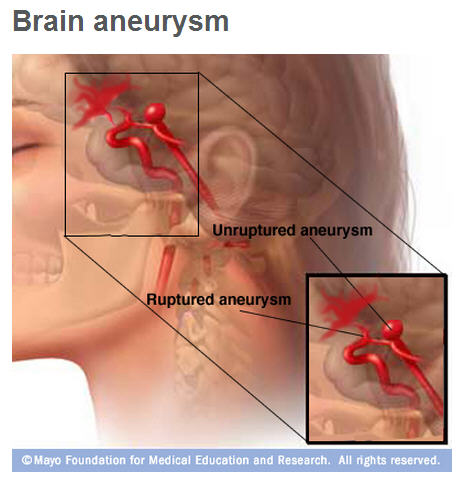-
Weekend Wellness: Treating or not treating unruptured brain aneurysm
DEAR MAYO CLINIC: During a recent MRI, my doctor detected a small, unruptured brain aneurysm. What could have caused this? How do you decide whether or not to treat an unruptured aneurysm?

ANSWER: A brain aneurysm is a bulge or balloon in a blood vessel in the brain. If it ruptures, a brain aneurysm can lead to serious health problems. But most small brain aneurysms do not rupture or require treatment. The decision to treat or not is based on a variety of considerations.
Arteries are blood vessels that bring blood from your heart to the rest of your body. They have thick walls with a smooth, thin inner lining. Over time, weak spots can develop in artery walls. When that happens, a bulge can develop. The bulge may progress to form a balloon shaped pouch on the artery, which is called an aneurysm.
A number of risk factors can affect your chances of developing a brain aneurysm. Brain aneurysms become more common with older age. High blood pressure can increase the likelihood of an aneurysm. Some brain aneurysms can be caused by blood infections or head injuries. Certain behaviors, such as smoking and using recreational drugs, also can raise the risk.
A brain aneurysm is a concern because it can leak or rupture, causing bleeding into or around the brain, a condition known as a hemorrhagic stroke. A ruptured aneurysm can quickly become life-threatening and requires prompt medical treatment.
Most brain aneurysms, however, don’t rupture, create health problems or cause symptoms. Such aneurysms are often detected during tests performed for other conditions or unrelated symptoms. When an unruptured aneurysm is found, there are many factors that go into the decision of whether or not to treat it.
Your physician compares the risk of rupture if the aneurysm is left alone to the risk of treatment. The aneurysm size, location and overall appearance play a role in the treatment decision, as do your health and medical history. Family history makes a difference, too. Research suggests that people with a parent, brother, sister or child who have had a ruptured brain aneurysm may be more likely to have one as well. Carefully considering this information can help you and your doctor weigh the risks and benefits of treating a brain aneurysm versus monitoring it.
If you decide to go ahead with treatment, several options are available. The first is microvascular clipping. During this procedure, a neurosurgeon removes a small section of the skull to access the aneurysm. The surgeon then locates the blood vessel that feeds the aneurysm and places a tiny metal clip across the base of the aneurysm to stop blood flow into it.
A second option is endovascular embolization. This is a less invasive alternative to surgical clipping. The doctor inserts a small plastic tube, or catheter, into an artery and threads it through your body into the brain arteries and then directly into the aneurysm. A spiral of soft platinum wire is pushed through the catheter. The wire immediately coils up inside the aneurysm, reducing blood flow into it.
A third treatment option, developed in the last several years, uses a device called a flow diverter. This small mesh device is placed over the aneurysm during a procedure similar to that of endovascular embolization. After the device is in place, blood flow to the aneurysm falls significantly. In many cases the aneurysm disappears.
If you decide not to treat the aneurysm, talk with your doctor about a monitoring schedule that’s right for you. Imaging exams may be performed from time to time to make sure the aneurysm is not getting bigger. You may be able to lower your risk of rupture by controlling high blood pressure, not smoking or using recreational drugs, exercising regularly, and, if you drink alcohol, only doing so in moderation. — Robert D. Brown, Jr., M.D., Neurology, Mayo Clinic, Rochester, Minn.







